Land Law and Property Rights
VerifiedAdded on 2020/11/23
|11
|3973
|183
Case Study
AI Summary
This assignment delves into the complexities of land law by examining significant case studies such as Jones v Kernott, Oxley v Hiscock, and Gissing v Gissing. Students must analyze the facts, legal arguments, and court rulings in each case, understanding how they shape property rights and ownership. The assignment also incorporates scholarly articles discussing contemporary issues in land law, including land use regulations, social inequalities, and land grabbing.
Contribute Materials
Your contribution can guide someone’s learning journey. Share your
documents today.
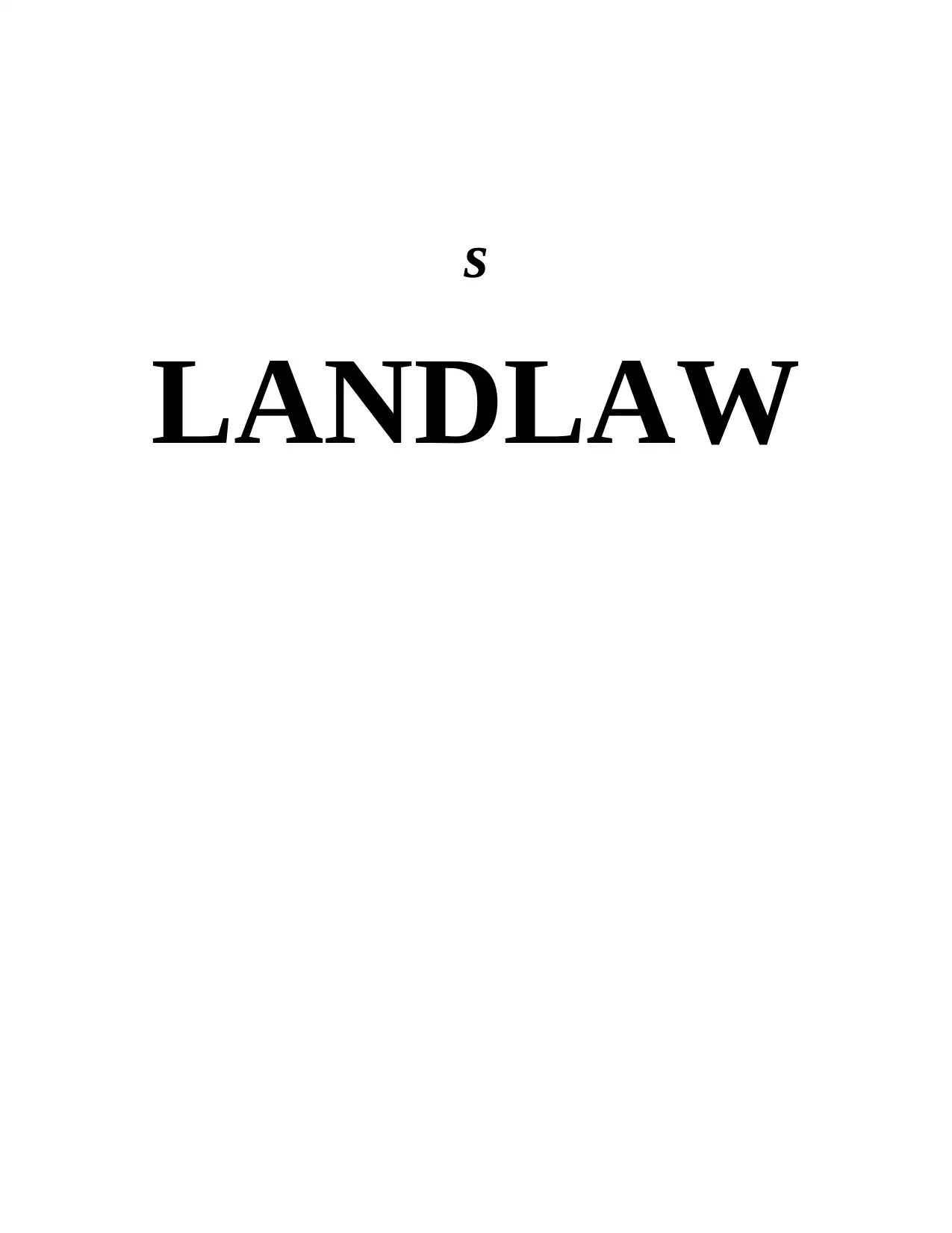
s
LANDLAW
LANDLAW
Secure Best Marks with AI Grader
Need help grading? Try our AI Grader for instant feedback on your assignments.

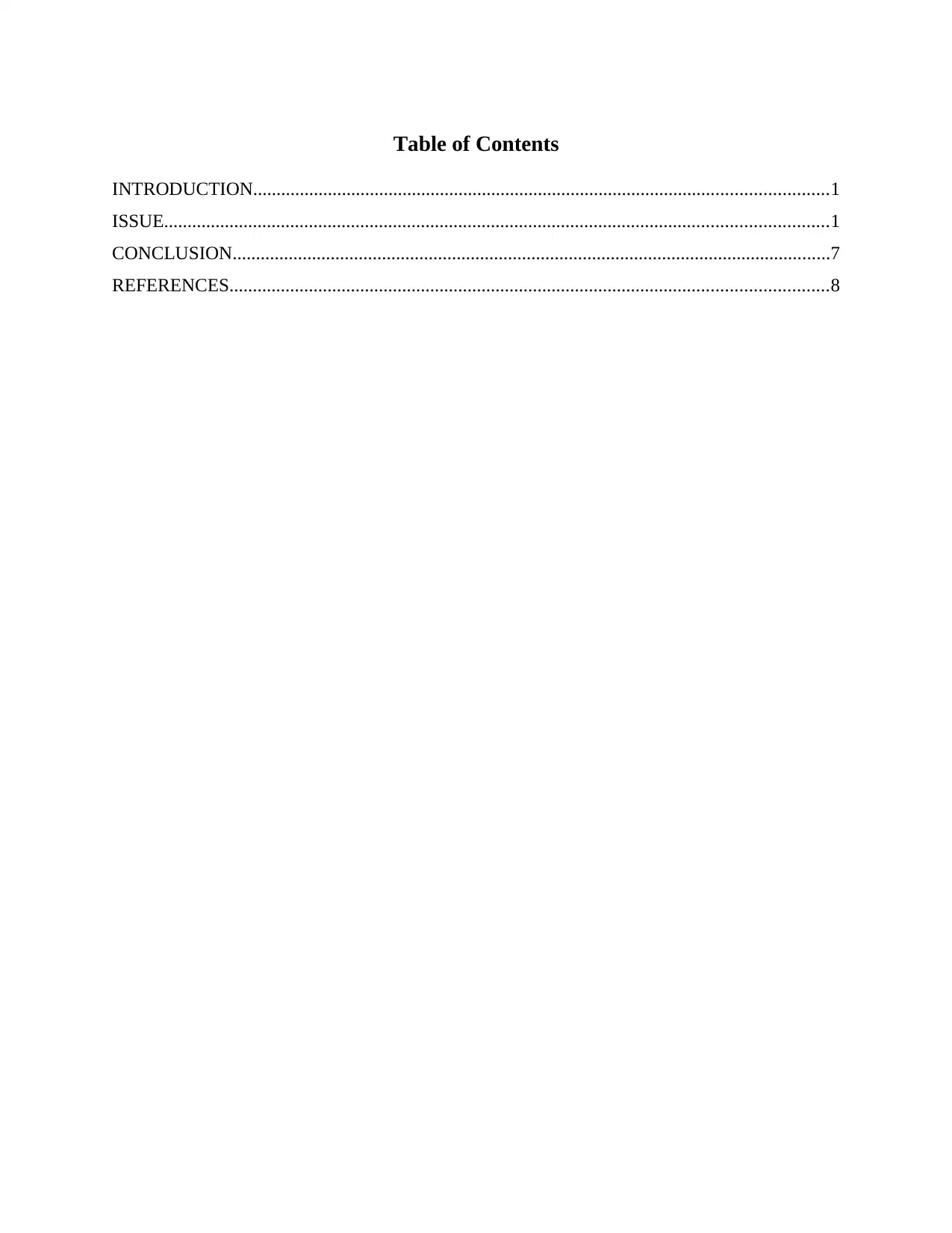
Table of Contents
INTRODUCTION...........................................................................................................................1
ISSUE..............................................................................................................................................1
CONCLUSION................................................................................................................................7
REFERENCES................................................................................................................................8
INTRODUCTION...........................................................................................................................1
ISSUE..............................................................................................................................................1
CONCLUSION................................................................................................................................7
REFERENCES................................................................................................................................8
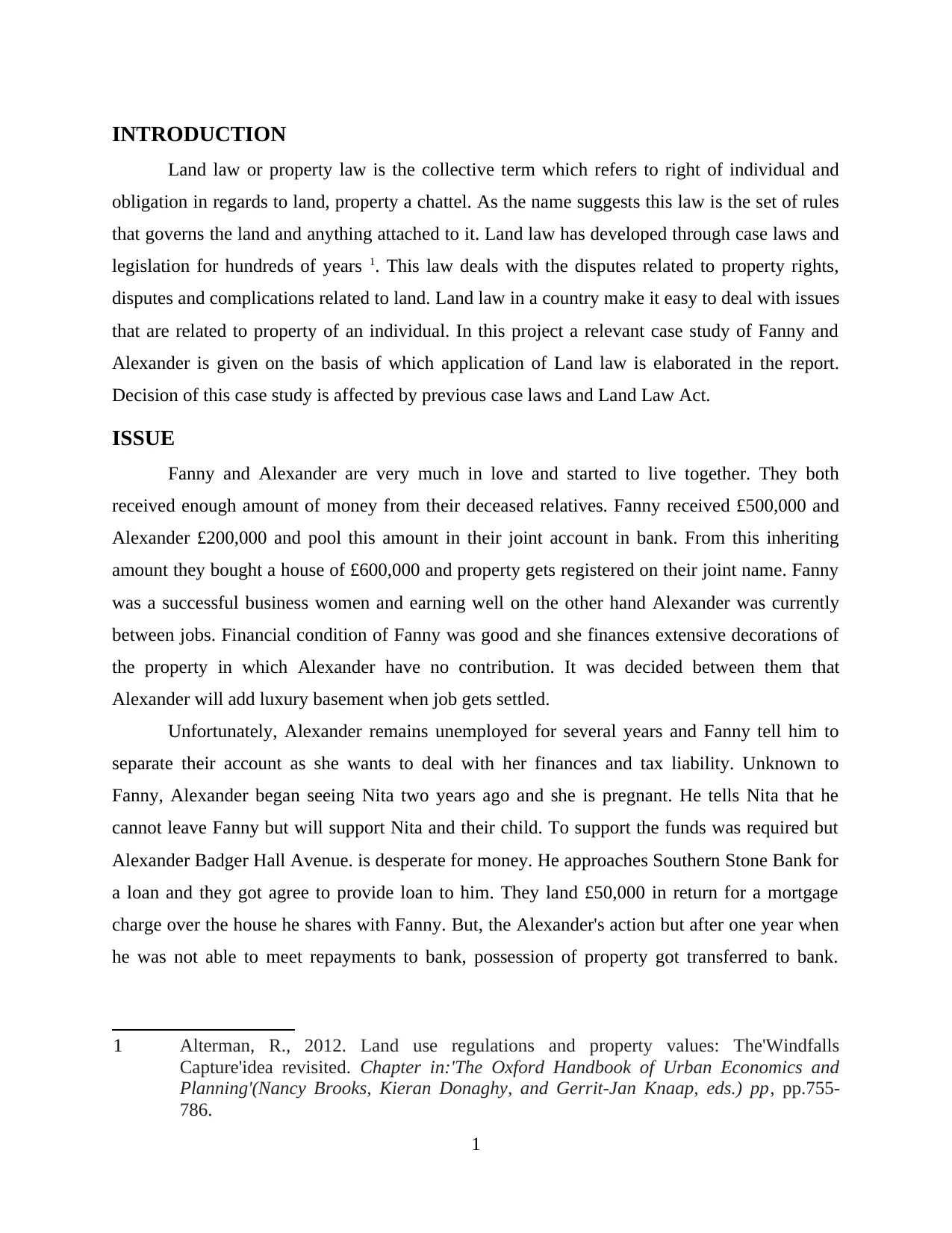
INTRODUCTION
Land law or property law is the collective term which refers to right of individual and
obligation in regards to land, property a chattel. As the name suggests this law is the set of rules
that governs the land and anything attached to it. Land law has developed through case laws and
legislation for hundreds of years 1. This law deals with the disputes related to property rights,
disputes and complications related to land. Land law in a country make it easy to deal with issues
that are related to property of an individual. In this project a relevant case study of Fanny and
Alexander is given on the basis of which application of Land law is elaborated in the report.
Decision of this case study is affected by previous case laws and Land Law Act.
ISSUE
Fanny and Alexander are very much in love and started to live together. They both
received enough amount of money from their deceased relatives. Fanny received £500,000 and
Alexander £200,000 and pool this amount in their joint account in bank. From this inheriting
amount they bought a house of £600,000 and property gets registered on their joint name. Fanny
was a successful business women and earning well on the other hand Alexander was currently
between jobs. Financial condition of Fanny was good and she finances extensive decorations of
the property in which Alexander have no contribution. It was decided between them that
Alexander will add luxury basement when job gets settled.
Unfortunately, Alexander remains unemployed for several years and Fanny tell him to
separate their account as she wants to deal with her finances and tax liability. Unknown to
Fanny, Alexander began seeing Nita two years ago and she is pregnant. He tells Nita that he
cannot leave Fanny but will support Nita and their child. To support the funds was required but
Alexander Badger Hall Avenue. is desperate for money. He approaches Southern Stone Bank for
a loan and they got agree to provide loan to him. They land £50,000 in return for a mortgage
charge over the house he shares with Fanny. But, the Alexander's action but after one year when
he was not able to meet repayments to bank, possession of property got transferred to bank.
1 Alterman, R., 2012. Land use regulations and property values: The'Windfalls
Capture'idea revisited. Chapter in:'The Oxford Handbook of Urban Economics and
Planning'(Nancy Brooks, Kieran Donaghy, and Gerrit-Jan Knaap, eds.) pp, pp.755-
786.
1
Land law or property law is the collective term which refers to right of individual and
obligation in regards to land, property a chattel. As the name suggests this law is the set of rules
that governs the land and anything attached to it. Land law has developed through case laws and
legislation for hundreds of years 1. This law deals with the disputes related to property rights,
disputes and complications related to land. Land law in a country make it easy to deal with issues
that are related to property of an individual. In this project a relevant case study of Fanny and
Alexander is given on the basis of which application of Land law is elaborated in the report.
Decision of this case study is affected by previous case laws and Land Law Act.
ISSUE
Fanny and Alexander are very much in love and started to live together. They both
received enough amount of money from their deceased relatives. Fanny received £500,000 and
Alexander £200,000 and pool this amount in their joint account in bank. From this inheriting
amount they bought a house of £600,000 and property gets registered on their joint name. Fanny
was a successful business women and earning well on the other hand Alexander was currently
between jobs. Financial condition of Fanny was good and she finances extensive decorations of
the property in which Alexander have no contribution. It was decided between them that
Alexander will add luxury basement when job gets settled.
Unfortunately, Alexander remains unemployed for several years and Fanny tell him to
separate their account as she wants to deal with her finances and tax liability. Unknown to
Fanny, Alexander began seeing Nita two years ago and she is pregnant. He tells Nita that he
cannot leave Fanny but will support Nita and their child. To support the funds was required but
Alexander Badger Hall Avenue. is desperate for money. He approaches Southern Stone Bank for
a loan and they got agree to provide loan to him. They land £50,000 in return for a mortgage
charge over the house he shares with Fanny. But, the Alexander's action but after one year when
he was not able to meet repayments to bank, possession of property got transferred to bank.
1 Alterman, R., 2012. Land use regulations and property values: The'Windfalls
Capture'idea revisited. Chapter in:'The Oxford Handbook of Urban Economics and
Planning'(Nancy Brooks, Kieran Donaghy, and Gerrit-Jan Knaap, eds.) pp, pp.755-
786.
1
Secure Best Marks with AI Grader
Need help grading? Try our AI Grader for instant feedback on your assignments.
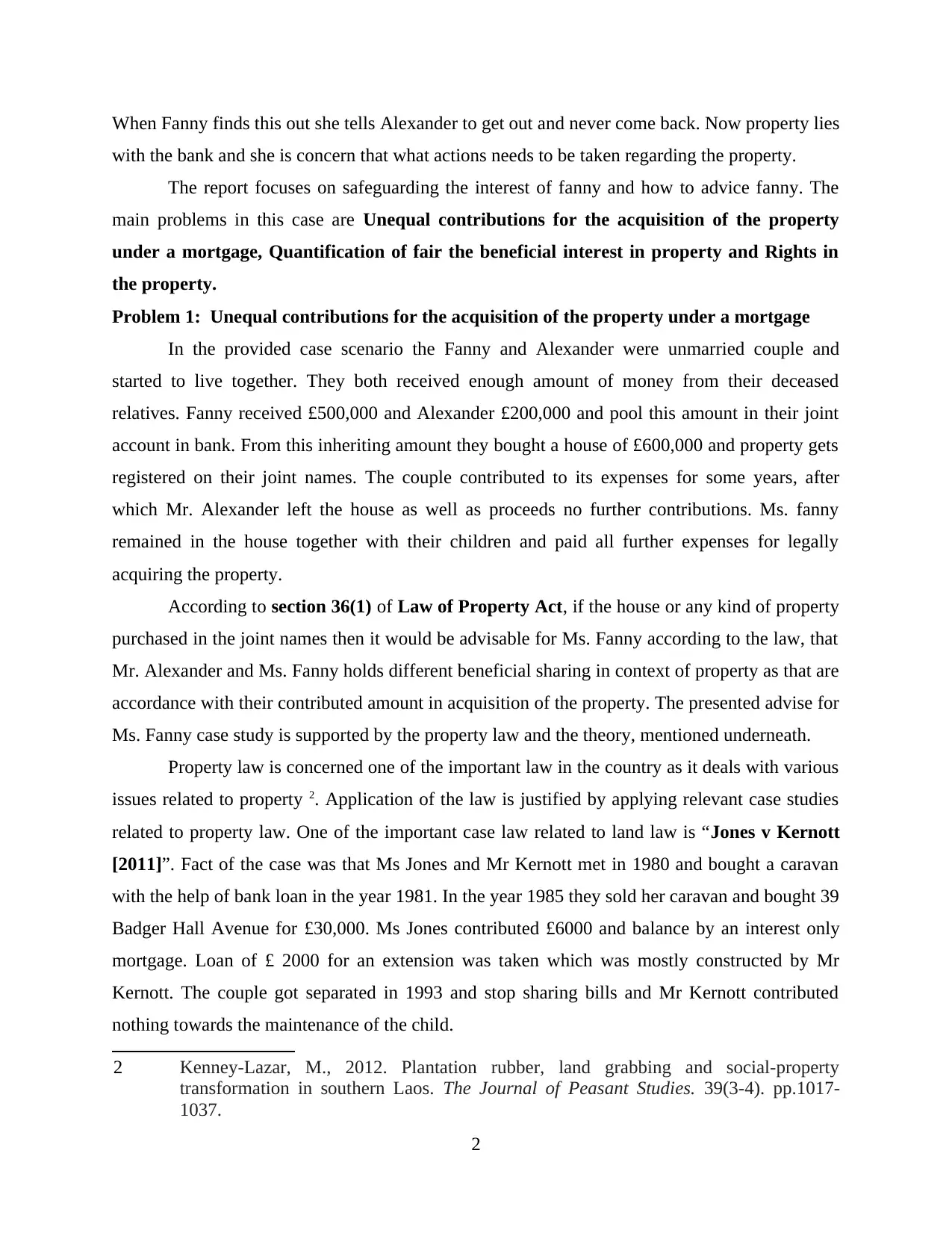
When Fanny finds this out she tells Alexander to get out and never come back. Now property lies
with the bank and she is concern that what actions needs to be taken regarding the property.
The report focuses on safeguarding the interest of fanny and how to advice fanny. The
main problems in this case are Unequal contributions for the acquisition of the property
under a mortgage, Quantification of fair the beneficial interest in property and Rights in
the property.
Problem 1: Unequal contributions for the acquisition of the property under a mortgage
In the provided case scenario the Fanny and Alexander were unmarried couple and
started to live together. They both received enough amount of money from their deceased
relatives. Fanny received £500,000 and Alexander £200,000 and pool this amount in their joint
account in bank. From this inheriting amount they bought a house of £600,000 and property gets
registered on their joint names. The couple contributed to its expenses for some years, after
which Mr. Alexander left the house as well as proceeds no further contributions. Ms. fanny
remained in the house together with their children and paid all further expenses for legally
acquiring the property.
According to section 36(1) of Law of Property Act, if the house or any kind of property
purchased in the joint names then it would be advisable for Ms. Fanny according to the law, that
Mr. Alexander and Ms. Fanny holds different beneficial sharing in context of property as that are
accordance with their contributed amount in acquisition of the property. The presented advise for
Ms. Fanny case study is supported by the property law and the theory, mentioned underneath.
Property law is concerned one of the important law in the country as it deals with various
issues related to property 2. Application of the law is justified by applying relevant case studies
related to property law. One of the important case law related to land law is “Jones v Kernott
[2011]”. Fact of the case was that Ms Jones and Mr Kernott met in 1980 and bought a caravan
with the help of bank loan in the year 1981. In the year 1985 they sold her caravan and bought 39
Badger Hall Avenue for £30,000. Ms Jones contributed £6000 and balance by an interest only
mortgage. Loan of £ 2000 for an extension was taken which was mostly constructed by Mr
Kernott. The couple got separated in 1993 and stop sharing bills and Mr Kernott contributed
nothing towards the maintenance of the child.
2 Kenney-Lazar, M., 2012. Plantation rubber, land grabbing and social-property
transformation in southern Laos. The Journal of Peasant Studies. 39(3-4). pp.1017-
1037.
2
with the bank and she is concern that what actions needs to be taken regarding the property.
The report focuses on safeguarding the interest of fanny and how to advice fanny. The
main problems in this case are Unequal contributions for the acquisition of the property
under a mortgage, Quantification of fair the beneficial interest in property and Rights in
the property.
Problem 1: Unequal contributions for the acquisition of the property under a mortgage
In the provided case scenario the Fanny and Alexander were unmarried couple and
started to live together. They both received enough amount of money from their deceased
relatives. Fanny received £500,000 and Alexander £200,000 and pool this amount in their joint
account in bank. From this inheriting amount they bought a house of £600,000 and property gets
registered on their joint names. The couple contributed to its expenses for some years, after
which Mr. Alexander left the house as well as proceeds no further contributions. Ms. fanny
remained in the house together with their children and paid all further expenses for legally
acquiring the property.
According to section 36(1) of Law of Property Act, if the house or any kind of property
purchased in the joint names then it would be advisable for Ms. Fanny according to the law, that
Mr. Alexander and Ms. Fanny holds different beneficial sharing in context of property as that are
accordance with their contributed amount in acquisition of the property. The presented advise for
Ms. Fanny case study is supported by the property law and the theory, mentioned underneath.
Property law is concerned one of the important law in the country as it deals with various
issues related to property 2. Application of the law is justified by applying relevant case studies
related to property law. One of the important case law related to land law is “Jones v Kernott
[2011]”. Fact of the case was that Ms Jones and Mr Kernott met in 1980 and bought a caravan
with the help of bank loan in the year 1981. In the year 1985 they sold her caravan and bought 39
Badger Hall Avenue for £30,000. Ms Jones contributed £6000 and balance by an interest only
mortgage. Loan of £ 2000 for an extension was taken which was mostly constructed by Mr
Kernott. The couple got separated in 1993 and stop sharing bills and Mr Kernott contributed
nothing towards the maintenance of the child.
2 Kenney-Lazar, M., 2012. Plantation rubber, land grabbing and social-property
transformation in southern Laos. The Journal of Peasant Studies. 39(3-4). pp.1017-
1037.
2

Furthermore, As per section 36(1) of law of Property Act, if there is more than one legal
owner of the land or property related to land then the land is automatically held on trust. Trust
must be created even if legal owners are the same people as the beneficiary. The law states that
the if a property is acquired by more than two owner jointly then they deserves the different
beneficial shares. As accordance with their contributed amount at the time of acquisition.
Besides this, the case study also supports the above statement that in May 2006 Mr
Kernott sought payment of his alleged half share in Badger Hall Avenue. Ms Jones responded by
claiming under Trust of Land for a deceleration that she owned the entire beneficial interest in
the property. Interest of the party in the property held by them jointly after separation will be
considered equally. A decision must be “fair and just” between the parties, taking into account
the whole couFanny works as a successful business woman and, from her earnings, which are
paid into the joint account, she finances extensive decoration and extension of the property,
including new fitted carpets throughout, and a new conservatory. Alexander works in the
creative industries but is currently ‘between jobs’.rse of dealing between them 3. In the
concerned case law taking into account the whole course of dealing between them. He concluded
that, taking into the account Mr Kernott ceasing to pay the bills and fact was that Ms Jones
contributed over 80% of the equity. In this given case high court of justice dismissed the appeal.
When case is filled with court of appeal in the year 2010, it was held that house both the persons
possess share of 50/50 in Badger Hall Avenue. On 9 November 2011, the supreme court of
United Kingdom, overturning the court of appeal held that share of Mr Kernott and Ms Jones in
the house on trust in a ratio of 10% to 90%. This case law involves Trusts of Land and
Appointment of Trustees Act which deals with the trusts. Co-owners of the property were
regarded as having beneficial interests in money and not in the land. This problem arises where
partners disagreed over when they wanted to sell the property 4.
From the above case law and decision held by supreme court in the case it can be
concluded that property will be distributed in the ratio of money invested. When a joint property
is sold by the partners in the case of separation then amount realised must be distributed in the
ratio of initial investment (must includes the further contributions made by the partners or
3 Pritchard, M. F., 2013. Land, power and peace: Tenure formalization, agricultural
reform, and livelihood insecurity in rural Rwanda. Land use policy. 30(1). pp.186-196.
4 Ruth Eikhof, D. and Warhurst, C., 2013. The promised land? Why social inequalities
are systemic in the creative industries. Employee Relations. 35(5). pp.495-508.
3
owner of the land or property related to land then the land is automatically held on trust. Trust
must be created even if legal owners are the same people as the beneficiary. The law states that
the if a property is acquired by more than two owner jointly then they deserves the different
beneficial shares. As accordance with their contributed amount at the time of acquisition.
Besides this, the case study also supports the above statement that in May 2006 Mr
Kernott sought payment of his alleged half share in Badger Hall Avenue. Ms Jones responded by
claiming under Trust of Land for a deceleration that she owned the entire beneficial interest in
the property. Interest of the party in the property held by them jointly after separation will be
considered equally. A decision must be “fair and just” between the parties, taking into account
the whole couFanny works as a successful business woman and, from her earnings, which are
paid into the joint account, she finances extensive decoration and extension of the property,
including new fitted carpets throughout, and a new conservatory. Alexander works in the
creative industries but is currently ‘between jobs’.rse of dealing between them 3. In the
concerned case law taking into account the whole course of dealing between them. He concluded
that, taking into the account Mr Kernott ceasing to pay the bills and fact was that Ms Jones
contributed over 80% of the equity. In this given case high court of justice dismissed the appeal.
When case is filled with court of appeal in the year 2010, it was held that house both the persons
possess share of 50/50 in Badger Hall Avenue. On 9 November 2011, the supreme court of
United Kingdom, overturning the court of appeal held that share of Mr Kernott and Ms Jones in
the house on trust in a ratio of 10% to 90%. This case law involves Trusts of Land and
Appointment of Trustees Act which deals with the trusts. Co-owners of the property were
regarded as having beneficial interests in money and not in the land. This problem arises where
partners disagreed over when they wanted to sell the property 4.
From the above case law and decision held by supreme court in the case it can be
concluded that property will be distributed in the ratio of money invested. When a joint property
is sold by the partners in the case of separation then amount realised must be distributed in the
ratio of initial investment (must includes the further contributions made by the partners or
3 Pritchard, M. F., 2013. Land, power and peace: Tenure formalization, agricultural
reform, and livelihood insecurity in rural Rwanda. Land use policy. 30(1). pp.186-196.
4 Ruth Eikhof, D. and Warhurst, C., 2013. The promised land? Why social inequalities
are systemic in the creative industries. Employee Relations. 35(5). pp.495-508.
3
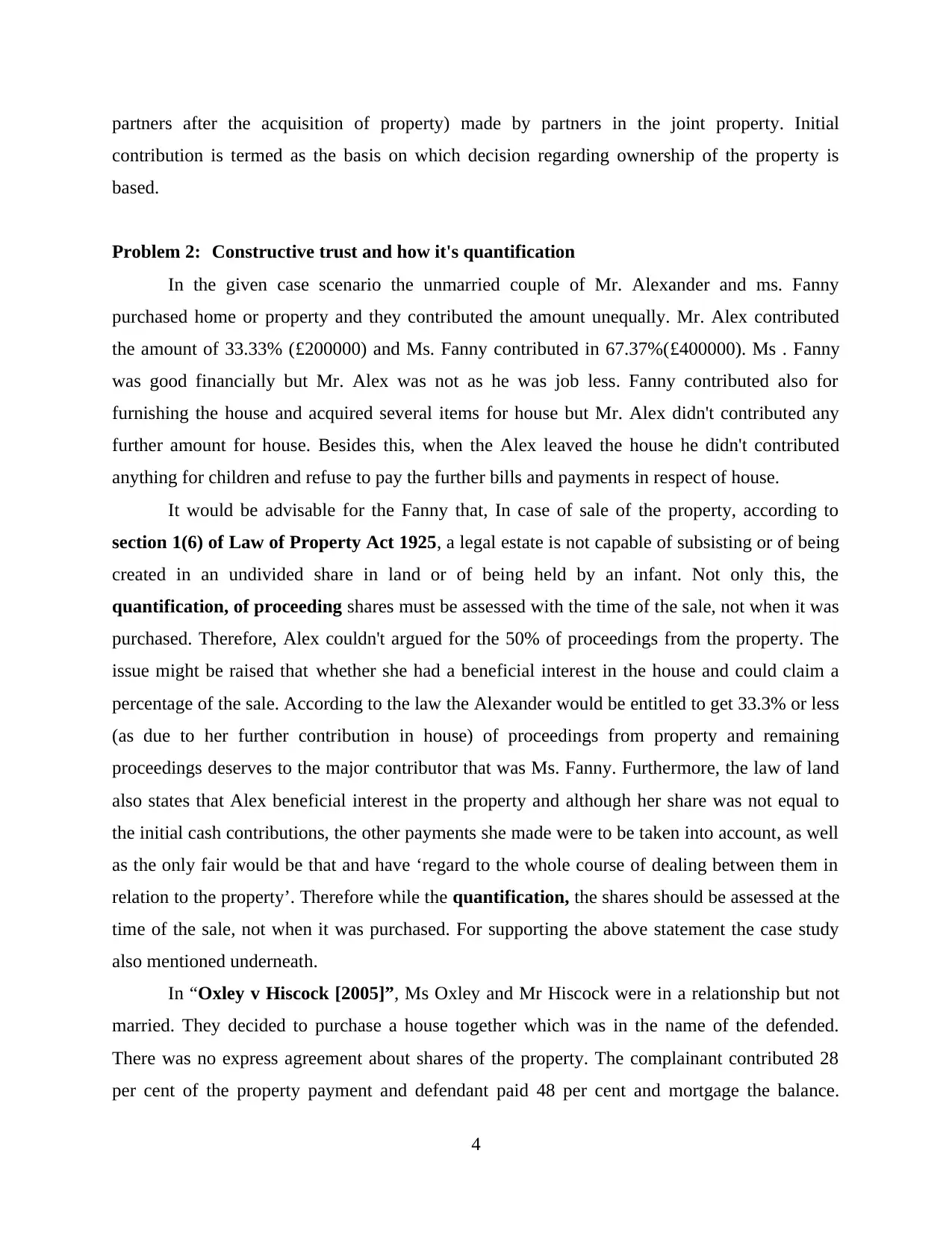
partners after the acquisition of property) made by partners in the joint property. Initial
contribution is termed as the basis on which decision regarding ownership of the property is
based.
Problem 2: Constructive trust and how it's quantification
In the given case scenario the unmarried couple of Mr. Alexander and ms. Fanny
purchased home or property and they contributed the amount unequally. Mr. Alex contributed
the amount of 33.33% (£200000) and Ms. Fanny contributed in 67.37%(£400000). Ms . Fanny
was good financially but Mr. Alex was not as he was job less. Fanny contributed also for
furnishing the house and acquired several items for house but Mr. Alex didn't contributed any
further amount for house. Besides this, when the Alex leaved the house he didn't contributed
anything for children and refuse to pay the further bills and payments in respect of house.
It would be advisable for the Fanny that, In case of sale of the property, according to
section 1(6) of Law of Property Act 1925, a legal estate is not capable of subsisting or of being
created in an undivided share in land or of being held by an infant. Not only this, the
quantification, of proceeding shares must be assessed with the time of the sale, not when it was
purchased. Therefore, Alex couldn't argued for the 50% of proceedings from the property. The
issue might be raised that whether she had a beneficial interest in the house and could claim a
percentage of the sale. According to the law the Alexander would be entitled to get 33.3% or less
(as due to her further contribution in house) of proceedings from property and remaining
proceedings deserves to the major contributor that was Ms. Fanny. Furthermore, the law of land
also states that Alex beneficial interest in the property and although her share was not equal to
the initial cash contributions, the other payments she made were to be taken into account, as well
as the only fair would be that and have ‘regard to the whole course of dealing between them in
relation to the property’. Therefore while the quantification, the shares should be assessed at the
time of the sale, not when it was purchased. For supporting the above statement the case study
also mentioned underneath.
In “Oxley v Hiscock [2005]”, Ms Oxley and Mr Hiscock were in a relationship but not
married. They decided to purchase a house together which was in the name of the defended.
There was no express agreement about shares of the property. The complainant contributed 28
per cent of the property payment and defendant paid 48 per cent and mortgage the balance.
4
contribution is termed as the basis on which decision regarding ownership of the property is
based.
Problem 2: Constructive trust and how it's quantification
In the given case scenario the unmarried couple of Mr. Alexander and ms. Fanny
purchased home or property and they contributed the amount unequally. Mr. Alex contributed
the amount of 33.33% (£200000) and Ms. Fanny contributed in 67.37%(£400000). Ms . Fanny
was good financially but Mr. Alex was not as he was job less. Fanny contributed also for
furnishing the house and acquired several items for house but Mr. Alex didn't contributed any
further amount for house. Besides this, when the Alex leaved the house he didn't contributed
anything for children and refuse to pay the further bills and payments in respect of house.
It would be advisable for the Fanny that, In case of sale of the property, according to
section 1(6) of Law of Property Act 1925, a legal estate is not capable of subsisting or of being
created in an undivided share in land or of being held by an infant. Not only this, the
quantification, of proceeding shares must be assessed with the time of the sale, not when it was
purchased. Therefore, Alex couldn't argued for the 50% of proceedings from the property. The
issue might be raised that whether she had a beneficial interest in the house and could claim a
percentage of the sale. According to the law the Alexander would be entitled to get 33.3% or less
(as due to her further contribution in house) of proceedings from property and remaining
proceedings deserves to the major contributor that was Ms. Fanny. Furthermore, the law of land
also states that Alex beneficial interest in the property and although her share was not equal to
the initial cash contributions, the other payments she made were to be taken into account, as well
as the only fair would be that and have ‘regard to the whole course of dealing between them in
relation to the property’. Therefore while the quantification, the shares should be assessed at the
time of the sale, not when it was purchased. For supporting the above statement the case study
also mentioned underneath.
In “Oxley v Hiscock [2005]”, Ms Oxley and Mr Hiscock were in a relationship but not
married. They decided to purchase a house together which was in the name of the defended.
There was no express agreement about shares of the property. The complainant contributed 28
per cent of the property payment and defendant paid 48 per cent and mortgage the balance.
4
Paraphrase This Document
Need a fresh take? Get an instant paraphrase of this document with our AI Paraphraser
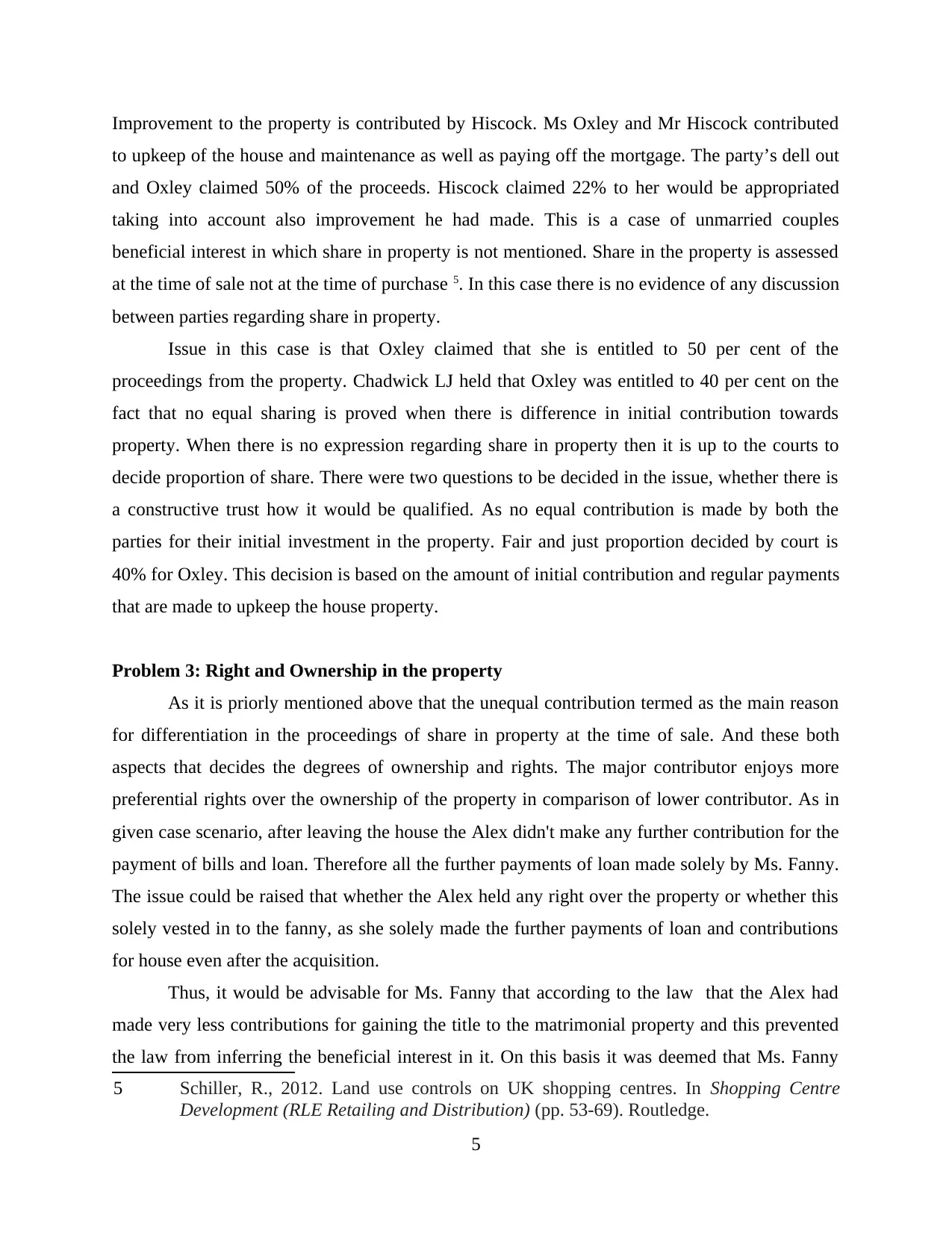
Improvement to the property is contributed by Hiscock. Ms Oxley and Mr Hiscock contributed
to upkeep of the house and maintenance as well as paying off the mortgage. The party’s dell out
and Oxley claimed 50% of the proceeds. Hiscock claimed 22% to her would be appropriated
taking into account also improvement he had made. This is a case of unmarried couples
beneficial interest in which share in property is not mentioned. Share in the property is assessed
at the time of sale not at the time of purchase 5. In this case there is no evidence of any discussion
between parties regarding share in property.
Issue in this case is that Oxley claimed that she is entitled to 50 per cent of the
proceedings from the property. Chadwick LJ held that Oxley was entitled to 40 per cent on the
fact that no equal sharing is proved when there is difference in initial contribution towards
property. When there is no expression regarding share in property then it is up to the courts to
decide proportion of share. There were two questions to be decided in the issue, whether there is
a constructive trust how it would be qualified. As no equal contribution is made by both the
parties for their initial investment in the property. Fair and just proportion decided by court is
40% for Oxley. This decision is based on the amount of initial contribution and regular payments
that are made to upkeep the house property.
Problem 3: Right and Ownership in the property
As it is priorly mentioned above that the unequal contribution termed as the main reason
for differentiation in the proceedings of share in property at the time of sale. And these both
aspects that decides the degrees of ownership and rights. The major contributor enjoys more
preferential rights over the ownership of the property in comparison of lower contributor. As in
given case scenario, after leaving the house the Alex didn't make any further contribution for the
payment of bills and loan. Therefore all the further payments of loan made solely by Ms. Fanny.
The issue could be raised that whether the Alex held any right over the property or whether this
solely vested in to the fanny, as she solely made the further payments of loan and contributions
for house even after the acquisition.
Thus, it would be advisable for Ms. Fanny that according to the law that the Alex had
made very less contributions for gaining the title to the matrimonial property and this prevented
the law from inferring the beneficial interest in it. On this basis it was deemed that Ms. Fanny
5 Schiller, R., 2012. Land use controls on UK shopping centres. In Shopping Centre
Development (RLE Retailing and Distribution) (pp. 53-69). Routledge.
5
to upkeep of the house and maintenance as well as paying off the mortgage. The party’s dell out
and Oxley claimed 50% of the proceeds. Hiscock claimed 22% to her would be appropriated
taking into account also improvement he had made. This is a case of unmarried couples
beneficial interest in which share in property is not mentioned. Share in the property is assessed
at the time of sale not at the time of purchase 5. In this case there is no evidence of any discussion
between parties regarding share in property.
Issue in this case is that Oxley claimed that she is entitled to 50 per cent of the
proceedings from the property. Chadwick LJ held that Oxley was entitled to 40 per cent on the
fact that no equal sharing is proved when there is difference in initial contribution towards
property. When there is no expression regarding share in property then it is up to the courts to
decide proportion of share. There were two questions to be decided in the issue, whether there is
a constructive trust how it would be qualified. As no equal contribution is made by both the
parties for their initial investment in the property. Fair and just proportion decided by court is
40% for Oxley. This decision is based on the amount of initial contribution and regular payments
that are made to upkeep the house property.
Problem 3: Right and Ownership in the property
As it is priorly mentioned above that the unequal contribution termed as the main reason
for differentiation in the proceedings of share in property at the time of sale. And these both
aspects that decides the degrees of ownership and rights. The major contributor enjoys more
preferential rights over the ownership of the property in comparison of lower contributor. As in
given case scenario, after leaving the house the Alex didn't make any further contribution for the
payment of bills and loan. Therefore all the further payments of loan made solely by Ms. Fanny.
The issue could be raised that whether the Alex held any right over the property or whether this
solely vested in to the fanny, as she solely made the further payments of loan and contributions
for house even after the acquisition.
Thus, it would be advisable for Ms. Fanny that according to the law that the Alex had
made very less contributions for gaining the title to the matrimonial property and this prevented
the law from inferring the beneficial interest in it. On this basis it was deemed that Ms. Fanny
5 Schiller, R., 2012. Land use controls on UK shopping centres. In Shopping Centre
Development (RLE Retailing and Distribution) (pp. 53-69). Routledge.
5

would held the sole beneficial interest in the property. The law section 34(2)(a) of Trustee Act
1925 wouldn't give the ownership authority or right to Alex over the property. But he could
apply for the appropriate relief after the case. For supporting the above statement the appropriate
case study also mentioned underneath.
When property is owned at joint name and at the time of any conflict related to ownership
of the property or proportion of share in the land then trust is created in land 6. Gissing v Gissing
[1971. The parties married in their early twenties and the wife worked throughout the marriage
as part of a printing company. The husband finished with the army when the wife found a role
for him as a printer in the company she worked for. He did well and bought a house in his name,
which they both lived before he left to live with someone else. The house purchased was based
on the majority of the finance being a mortgage and the rest coming by way of a loan from the
printing company. The husband paid the mortgage, gave his wife a living allowance each week
and paid for holidays. The wife paid for furniture for the property and her and their son’s
clothing. When he left, the wife remained in the house and the husband paid the mortgage. When
the divorce was granted the order for maintenance was significantly reduced. The trial judge
found that the husband was entitled to possession and the Court of Appeal reversed that decision.
The husband appealed. The court allowed the husband’s appeal. It was found that the wife had
not made a contribution to gaining the title to the matrimonial property and this prevented the
court from inferring the beneficial interest in it. On this basis, it was deemed that the husband
held the sole beneficial interest in the property. The court did give the wife the opportunity to
apply for the appropriate relief after the case.
As per section 34(2)(a) of Trustee Act 1925 the number of trustees are defined in the act.
Therefore, number of trustees in any case shall not exceed four and where more than four
persons are named as trustee then first four names shall be considered as trustee. This limit exists
only for number of trustees but there is no limit for number of co-owners in equity. When two
persons acquires a property as joint tenants then both the tenants have same right of possession
but not interest, title and time in the property. Tenants in common are only entitled to a share of
estate not the entire estate. When a property is acquired jointly the share in the property leaves
undivided until the property is sold. In A.G Securities v Vaughan case in the year 1990, four
6 Green, L. C., 2018. The contemporary law of armed conflict.
6
1925 wouldn't give the ownership authority or right to Alex over the property. But he could
apply for the appropriate relief after the case. For supporting the above statement the appropriate
case study also mentioned underneath.
When property is owned at joint name and at the time of any conflict related to ownership
of the property or proportion of share in the land then trust is created in land 6. Gissing v Gissing
[1971. The parties married in their early twenties and the wife worked throughout the marriage
as part of a printing company. The husband finished with the army when the wife found a role
for him as a printer in the company she worked for. He did well and bought a house in his name,
which they both lived before he left to live with someone else. The house purchased was based
on the majority of the finance being a mortgage and the rest coming by way of a loan from the
printing company. The husband paid the mortgage, gave his wife a living allowance each week
and paid for holidays. The wife paid for furniture for the property and her and their son’s
clothing. When he left, the wife remained in the house and the husband paid the mortgage. When
the divorce was granted the order for maintenance was significantly reduced. The trial judge
found that the husband was entitled to possession and the Court of Appeal reversed that decision.
The husband appealed. The court allowed the husband’s appeal. It was found that the wife had
not made a contribution to gaining the title to the matrimonial property and this prevented the
court from inferring the beneficial interest in it. On this basis, it was deemed that the husband
held the sole beneficial interest in the property. The court did give the wife the opportunity to
apply for the appropriate relief after the case.
As per section 34(2)(a) of Trustee Act 1925 the number of trustees are defined in the act.
Therefore, number of trustees in any case shall not exceed four and where more than four
persons are named as trustee then first four names shall be considered as trustee. This limit exists
only for number of trustees but there is no limit for number of co-owners in equity. When two
persons acquires a property as joint tenants then both the tenants have same right of possession
but not interest, title and time in the property. Tenants in common are only entitled to a share of
estate not the entire estate. When a property is acquired jointly the share in the property leaves
undivided until the property is sold. In A.G Securities v Vaughan case in the year 1990, four
6 Green, L. C., 2018. The contemporary law of armed conflict.
6
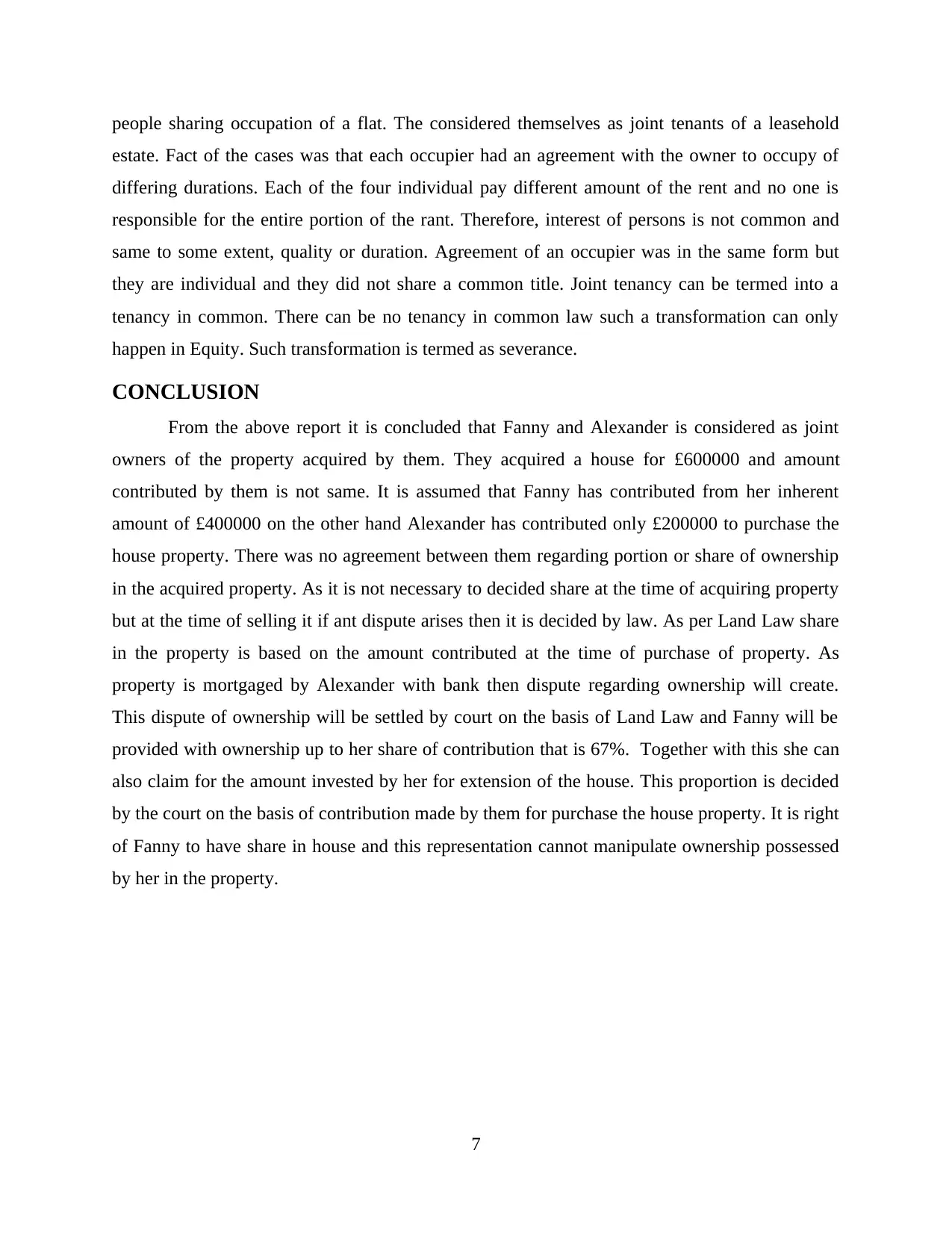
people sharing occupation of a flat. The considered themselves as joint tenants of a leasehold
estate. Fact of the cases was that each occupier had an agreement with the owner to occupy of
differing durations. Each of the four individual pay different amount of the rent and no one is
responsible for the entire portion of the rant. Therefore, interest of persons is not common and
same to some extent, quality or duration. Agreement of an occupier was in the same form but
they are individual and they did not share a common title. Joint tenancy can be termed into a
tenancy in common. There can be no tenancy in common law such a transformation can only
happen in Equity. Such transformation is termed as severance.
CONCLUSION
From the above report it is concluded that Fanny and Alexander is considered as joint
owners of the property acquired by them. They acquired a house for £600000 and amount
contributed by them is not same. It is assumed that Fanny has contributed from her inherent
amount of £400000 on the other hand Alexander has contributed only £200000 to purchase the
house property. There was no agreement between them regarding portion or share of ownership
in the acquired property. As it is not necessary to decided share at the time of acquiring property
but at the time of selling it if ant dispute arises then it is decided by law. As per Land Law share
in the property is based on the amount contributed at the time of purchase of property. As
property is mortgaged by Alexander with bank then dispute regarding ownership will create.
This dispute of ownership will be settled by court on the basis of Land Law and Fanny will be
provided with ownership up to her share of contribution that is 67%. Together with this she can
also claim for the amount invested by her for extension of the house. This proportion is decided
by the court on the basis of contribution made by them for purchase the house property. It is right
of Fanny to have share in house and this representation cannot manipulate ownership possessed
by her in the property.
7
estate. Fact of the cases was that each occupier had an agreement with the owner to occupy of
differing durations. Each of the four individual pay different amount of the rent and no one is
responsible for the entire portion of the rant. Therefore, interest of persons is not common and
same to some extent, quality or duration. Agreement of an occupier was in the same form but
they are individual and they did not share a common title. Joint tenancy can be termed into a
tenancy in common. There can be no tenancy in common law such a transformation can only
happen in Equity. Such transformation is termed as severance.
CONCLUSION
From the above report it is concluded that Fanny and Alexander is considered as joint
owners of the property acquired by them. They acquired a house for £600000 and amount
contributed by them is not same. It is assumed that Fanny has contributed from her inherent
amount of £400000 on the other hand Alexander has contributed only £200000 to purchase the
house property. There was no agreement between them regarding portion or share of ownership
in the acquired property. As it is not necessary to decided share at the time of acquiring property
but at the time of selling it if ant dispute arises then it is decided by law. As per Land Law share
in the property is based on the amount contributed at the time of purchase of property. As
property is mortgaged by Alexander with bank then dispute regarding ownership will create.
This dispute of ownership will be settled by court on the basis of Land Law and Fanny will be
provided with ownership up to her share of contribution that is 67%. Together with this she can
also claim for the amount invested by her for extension of the house. This proportion is decided
by the court on the basis of contribution made by them for purchase the house property. It is right
of Fanny to have share in house and this representation cannot manipulate ownership possessed
by her in the property.
7
Secure Best Marks with AI Grader
Need help grading? Try our AI Grader for instant feedback on your assignments.
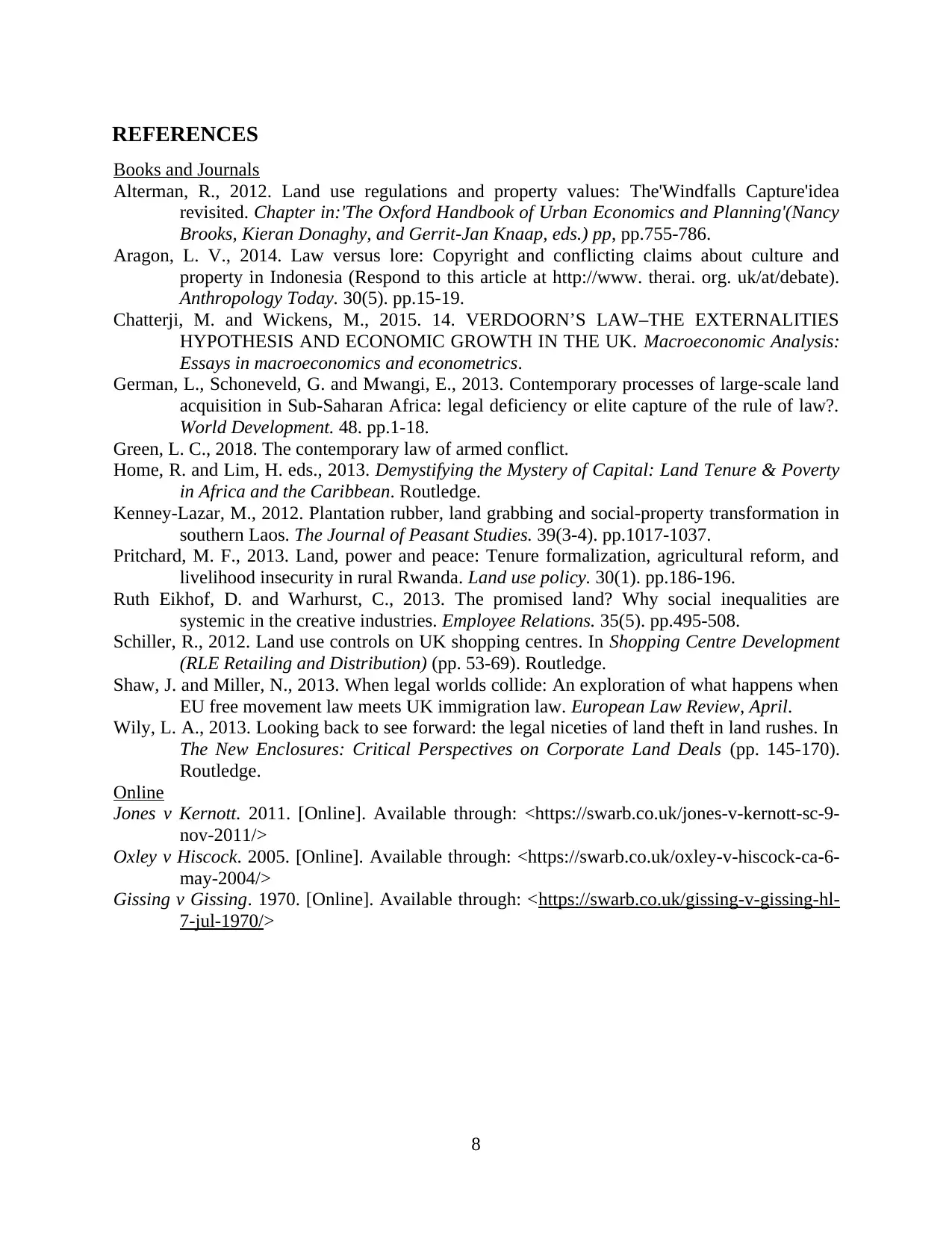
REFERENCES
Books and Journals
Alterman, R., 2012. Land use regulations and property values: The'Windfalls Capture'idea
revisited. Chapter in:'The Oxford Handbook of Urban Economics and Planning'(Nancy
Brooks, Kieran Donaghy, and Gerrit-Jan Knaap, eds.) pp, pp.755-786.
Aragon, L. V., 2014. Law versus lore: Copyright and conflicting claims about culture and
property in Indonesia (Respond to this article at http://www. therai. org. uk/at/debate).
Anthropology Today. 30(5). pp.15-19.
Chatterji, M. and Wickens, M., 2015. 14. VERDOORN’S LAW–THE EXTERNALITIES
HYPOTHESIS AND ECONOMIC GROWTH IN THE UK. Macroeconomic Analysis:
Essays in macroeconomics and econometrics.
German, L., Schoneveld, G. and Mwangi, E., 2013. Contemporary processes of large-scale land
acquisition in Sub-Saharan Africa: legal deficiency or elite capture of the rule of law?.
World Development. 48. pp.1-18.
Green, L. C., 2018. The contemporary law of armed conflict.
Home, R. and Lim, H. eds., 2013. Demystifying the Mystery of Capital: Land Tenure & Poverty
in Africa and the Caribbean. Routledge.
Kenney-Lazar, M., 2012. Plantation rubber, land grabbing and social-property transformation in
southern Laos. The Journal of Peasant Studies. 39(3-4). pp.1017-1037.
Pritchard, M. F., 2013. Land, power and peace: Tenure formalization, agricultural reform, and
livelihood insecurity in rural Rwanda. Land use policy. 30(1). pp.186-196.
Ruth Eikhof, D. and Warhurst, C., 2013. The promised land? Why social inequalities are
systemic in the creative industries. Employee Relations. 35(5). pp.495-508.
Schiller, R., 2012. Land use controls on UK shopping centres. In Shopping Centre Development
(RLE Retailing and Distribution) (pp. 53-69). Routledge.
Shaw, J. and Miller, N., 2013. When legal worlds collide: An exploration of what happens when
EU free movement law meets UK immigration law. European Law Review, April.
Wily, L. A., 2013. Looking back to see forward: the legal niceties of land theft in land rushes. In
The New Enclosures: Critical Perspectives on Corporate Land Deals (pp. 145-170).
Routledge.
Online
Jones v Kernott. 2011. [Online]. Available through: <https://swarb.co.uk/jones-v-kernott-sc-9-
nov-2011/>
Oxley v Hiscock. 2005. [Online]. Available through: <https://swarb.co.uk/oxley-v-hiscock-ca-6-
may-2004/>
Gissing v Gissing. 1970. [Online]. Available through: <https://swarb.co.uk/gissing-v-gissing-hl-
7-jul-1970/>
8
Books and Journals
Alterman, R., 2012. Land use regulations and property values: The'Windfalls Capture'idea
revisited. Chapter in:'The Oxford Handbook of Urban Economics and Planning'(Nancy
Brooks, Kieran Donaghy, and Gerrit-Jan Knaap, eds.) pp, pp.755-786.
Aragon, L. V., 2014. Law versus lore: Copyright and conflicting claims about culture and
property in Indonesia (Respond to this article at http://www. therai. org. uk/at/debate).
Anthropology Today. 30(5). pp.15-19.
Chatterji, M. and Wickens, M., 2015. 14. VERDOORN’S LAW–THE EXTERNALITIES
HYPOTHESIS AND ECONOMIC GROWTH IN THE UK. Macroeconomic Analysis:
Essays in macroeconomics and econometrics.
German, L., Schoneveld, G. and Mwangi, E., 2013. Contemporary processes of large-scale land
acquisition in Sub-Saharan Africa: legal deficiency or elite capture of the rule of law?.
World Development. 48. pp.1-18.
Green, L. C., 2018. The contemporary law of armed conflict.
Home, R. and Lim, H. eds., 2013. Demystifying the Mystery of Capital: Land Tenure & Poverty
in Africa and the Caribbean. Routledge.
Kenney-Lazar, M., 2012. Plantation rubber, land grabbing and social-property transformation in
southern Laos. The Journal of Peasant Studies. 39(3-4). pp.1017-1037.
Pritchard, M. F., 2013. Land, power and peace: Tenure formalization, agricultural reform, and
livelihood insecurity in rural Rwanda. Land use policy. 30(1). pp.186-196.
Ruth Eikhof, D. and Warhurst, C., 2013. The promised land? Why social inequalities are
systemic in the creative industries. Employee Relations. 35(5). pp.495-508.
Schiller, R., 2012. Land use controls on UK shopping centres. In Shopping Centre Development
(RLE Retailing and Distribution) (pp. 53-69). Routledge.
Shaw, J. and Miller, N., 2013. When legal worlds collide: An exploration of what happens when
EU free movement law meets UK immigration law. European Law Review, April.
Wily, L. A., 2013. Looking back to see forward: the legal niceties of land theft in land rushes. In
The New Enclosures: Critical Perspectives on Corporate Land Deals (pp. 145-170).
Routledge.
Online
Jones v Kernott. 2011. [Online]. Available through: <https://swarb.co.uk/jones-v-kernott-sc-9-
nov-2011/>
Oxley v Hiscock. 2005. [Online]. Available through: <https://swarb.co.uk/oxley-v-hiscock-ca-6-
may-2004/>
Gissing v Gissing. 1970. [Online]. Available through: <https://swarb.co.uk/gissing-v-gissing-hl-
7-jul-1970/>
8
1 out of 11
Related Documents
Your All-in-One AI-Powered Toolkit for Academic Success.
+13062052269
info@desklib.com
Available 24*7 on WhatsApp / Email
![[object Object]](/_next/static/media/star-bottom.7253800d.svg)
Unlock your academic potential
© 2024 | Zucol Services PVT LTD | All rights reserved.





